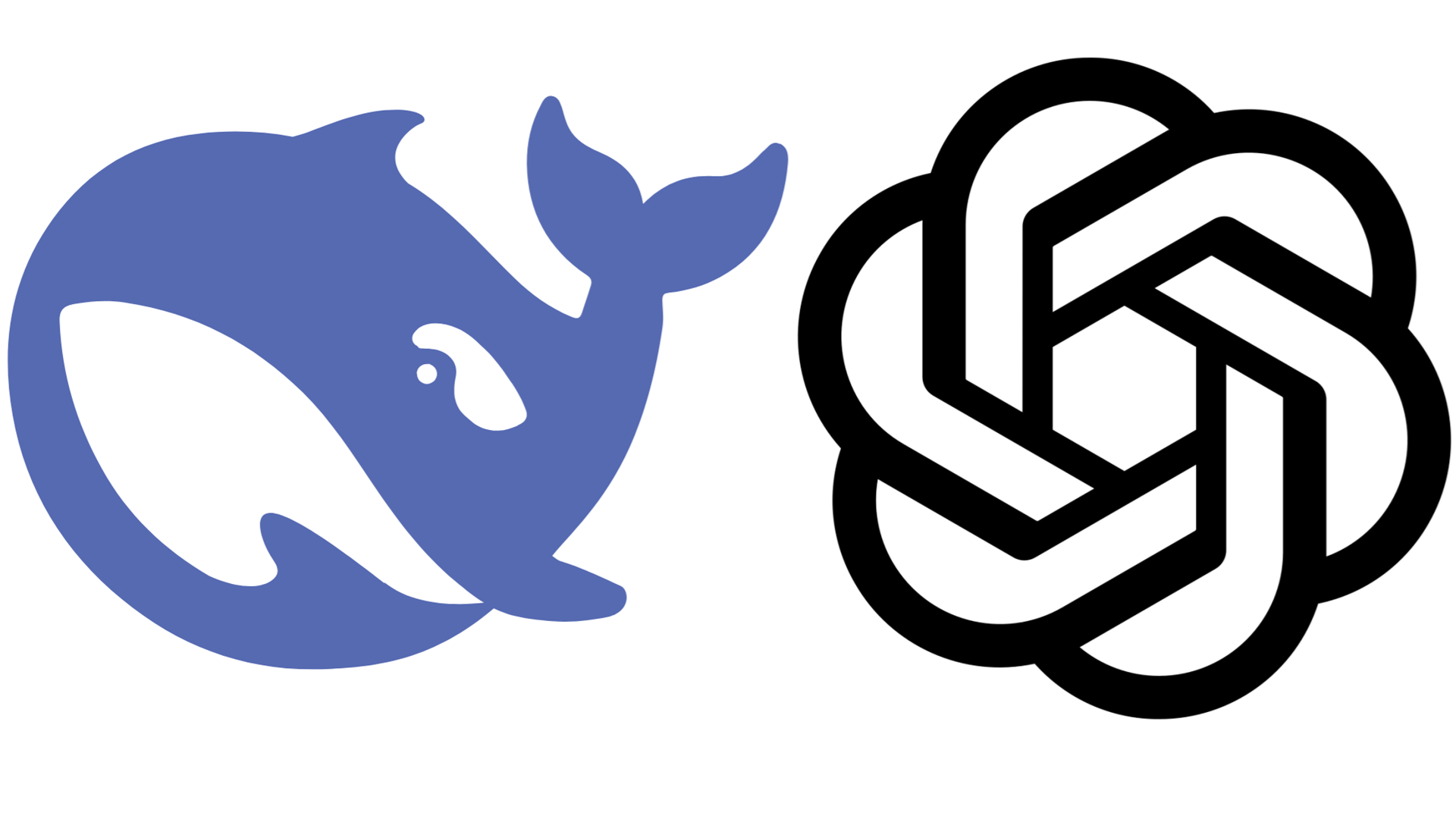What separates AI leaders from laggards
The Fast Company Impact Council is an invitation-only membership community of leaders, experts, executives, and entrepreneurs who share their insights with our audience. Members pay annual dues for access to peer learning, thought leadership opportunities, events and more. In most companies, generative AI is full of contradictions. On one hand, 67% of business leaders predict that GenAI will transform their organization in 2025, according to a KPMG survey. On the other, just 36% of executives say their company has a well-defined vision for AI. The core issue: Nearly 2.5 years after ChatGPT’s introduction, most companies are still stuck in what I call “prototype purgatory.” They’ve bought and attempted to adopt off-the-shelf GenAI tools and developed pet project prototypes. But despite big promises from vendors or demos, they’ve generated little more than incremental value—far from the AI revolution that was promised. I see this constantly when talking to enterprise execs. They’re frustrated. And the data bears this out, too. Recently at A.Team, we surveyed 250 senior tech leaders responsible for AI initiatives at their companies and found that only 36% of organizations have successfully deployed AI to production. (The majority of respondents came from enterprise companies.) The rest remain caught in an endless cycle of proof of concept projects and pilots—or haven’t gotten started at all. It’s not hard to see why this is happening. The space is moving at whiplash speed, disrupting itself weekly. It’s impossible to upskill your full-time employees on all things AI, which makes it difficult to make crucial technical decisions. At this stage of the game, locking into one platform is highly premature. But amidst these struggles, some companies are breaking through. The most fascinating part of our research was what AI leaders do differently than AI laggards—and it’s not what you might expect. The talent equation: Blended teams win The most striking finding from our research was that organizations that use blended teams—a model that integrates specialized freelance talent with full-time employees—are twice as likely to reach advanced stages of AI innovation. These companies find that this model helps alleviate the AI talent crisis that most companies are experiencing. Ninety-four percent of the tech leaders we surveyed said talent constraints are their primary barrier to innovation, with 85% having delayed critical AI initiatives due to talent shortages. [Graphic: A.Team 2025 State of AI Innovation Report] They’re finding that traditional hiring can’t solve this problem—89% said the traditional recruitment model is broken. Two-thirds of respondents said it takes at least 4 months to hire top engineering talent. These protracted hiring cycles are particularly problematic in AI development, where technology evolves at a breakneck pace—rendering traditional workforce planning obsolete as new possibilities emerge and roadmaps change. In 2025, it’s hard to know the exact skills you will need in six months. Successful organizations that have escaped prototype purgatory have found a different approach with blended teams, and they report stunning improvements from incorporating freelance or fractional talent into their teams: 99% enhanced innovation capability 98% improved project success rates 96% accelerated speed of delivery [Graphic: A.Team 2025 State of AI Innovation Report] Build versus buy: A third way may be the answer For the past 2.5 years, I’ve watched “build vs. buy” become one of the dominant discussions in executive boardrooms. While off-the-shelf AI tools like ChatGPT Enterprise and GitHub Copilot deliver obvious value, it now looks like the “build” approach is winning. Among companies that have successfully deployed AI to production, 93% say building custom solutions delivers more value than off-the-shelf tools. But that might not be the whole story. The most successful organizations aren’t building everything from scratch, however. They’re taking an “assemble” approach—leveraging the explosion of open-source building blocks (we’ve seen a 60% boom in open-source GenAI contributions on GitHub in the past year alone) while customizing solutions for their specific needs. The “assemble” model is built for speed; integrated components can be easily updated or swapped out, which is crucial when the shelf life for state of the art AI is shorter than a jar of organic marinara sauce. It allows you to keep the most crucial part in place: developing these GenAI components into existing workflows that empower your employees and customers, giving you a true data moat. When you look at where the senior tech leaders in our study are making their investments, it reflects this kind of foundational approach: 50% are increasing spending on AI safety and monitoring tools 49% are prioritizing AI development platforms 41% are investing in data infr

The Fast Company Impact Council is an invitation-only membership community of leaders, experts, executives, and entrepreneurs who share their insights with our audience. Members pay annual dues for access to peer learning, thought leadership opportunities, events and more.
In most companies, generative AI is full of contradictions.
On one hand, 67% of business leaders predict that GenAI will transform their organization in 2025, according to a KPMG survey. On the other, just 36% of executives say their company has a well-defined vision for AI.
The core issue: Nearly 2.5 years after ChatGPT’s introduction, most companies are still stuck in what I call “prototype purgatory.” They’ve bought and attempted to adopt off-the-shelf GenAI tools and developed pet project prototypes. But despite big promises from vendors or demos, they’ve generated little more than incremental value—far from the AI revolution that was promised.
I see this constantly when talking to enterprise execs. They’re frustrated. And the data bears this out, too. Recently at A.Team, we surveyed 250 senior tech leaders responsible for AI initiatives at their companies and found that only 36% of organizations have successfully deployed AI to production. (The majority of respondents came from enterprise companies.) The rest remain caught in an endless cycle of proof of concept projects and pilots—or haven’t gotten started at all.
It’s not hard to see why this is happening. The space is moving at whiplash speed, disrupting itself weekly. It’s impossible to upskill your full-time employees on all things AI, which makes it difficult to make crucial technical decisions. At this stage of the game, locking into one platform is highly premature.
But amidst these struggles, some companies are breaking through. The most fascinating part of our research was what AI leaders do differently than AI laggards—and it’s not what you might expect.
The talent equation: Blended teams win
The most striking finding from our research was that organizations that use blended teams—a model that integrates specialized freelance talent with full-time employees—are twice as likely to reach advanced stages of AI innovation.
These companies find that this model helps alleviate the AI talent crisis that most companies are experiencing. Ninety-four percent of the tech leaders we surveyed said talent constraints are their primary barrier to innovation, with 85% having delayed critical AI initiatives due to talent shortages.

They’re finding that traditional hiring can’t solve this problem—89% said the traditional recruitment model is broken. Two-thirds of respondents said it takes at least 4 months to hire top engineering talent. These protracted hiring cycles are particularly problematic in AI development, where technology evolves at a breakneck pace—rendering traditional workforce planning obsolete as new possibilities emerge and roadmaps change. In 2025, it’s hard to know the exact skills you will need in six months.
Successful organizations that have escaped prototype purgatory have found a different approach with blended teams, and they report stunning improvements from incorporating freelance or fractional talent into their teams:
- 99% enhanced innovation capability
- 98% improved project success rates
- 96% accelerated speed of delivery

Build versus buy: A third way may be the answer
For the past 2.5 years, I’ve watched “build vs. buy” become one of the dominant discussions in executive boardrooms. While off-the-shelf AI tools like ChatGPT Enterprise and GitHub Copilot deliver obvious value, it now looks like the “build” approach is winning. Among companies that have successfully deployed AI to production, 93% say building custom solutions delivers more value than off-the-shelf tools. But that might not be the whole story.
The most successful organizations aren’t building everything from scratch, however. They’re taking an “assemble” approach—leveraging the explosion of open-source building blocks (we’ve seen a 60% boom in open-source GenAI contributions on GitHub in the past year alone) while customizing solutions for their specific needs.
The “assemble” model is built for speed; integrated components can be easily updated or swapped out, which is crucial when the shelf life for state of the art AI is shorter than a jar of organic marinara sauce. It allows you to keep the most crucial part in place: developing these GenAI components into existing workflows that empower your employees and customers, giving you a true data moat.
When you look at where the senior tech leaders in our study are making their investments, it reflects this kind of foundational approach:
- 50% are increasing spending on AI safety and monitoring tools
- 49% are prioritizing AI development platforms
- 41% are investing in data infrastructure

They’re not investing in the models themselves but in everything needed to turn them into production-grade systems: data pipelines, testing frameworks, monitoring tools, and integration capabilities.
Want ROI? Start with AI-powered automation
One of the biggest questions about generative AI is: Are companies seeing ROI? And if so, where?
We got the answer by asking AI leaders their expected ROI timeline across four key areas of focus:
- Custom AI product development
- AI-powered automation
- Customer-facing AI features
- Internal AI tools

Not surprisingly, AI-powered automation had the highest ROI rate already achieved, at 14%. Surprisingly, customer AI product development came in second, at 12%. Perhaps most surprisingly, most leaders expect to see ROI across every use case this year.
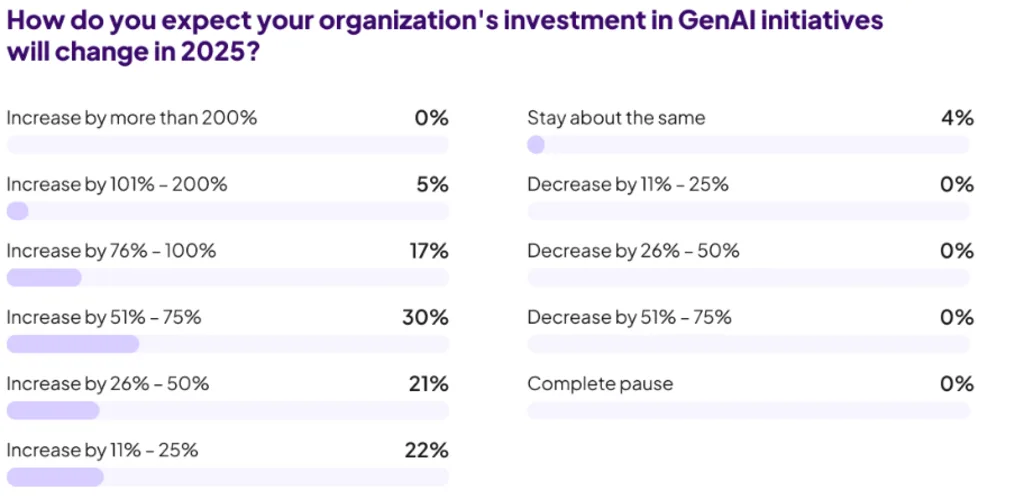
Our research suggests that a significant portion of that investment will go into custom AI product development and customer-facing AI features. While the dominant AI discussion has focused on cost cutting, more respondents said they were focusing on generating ROI through revenue generation (46%) over cost cutting (30%).

It’s been said a million times, but it bears repeating: This will be a critical year for AI development inside most companies, with many Fortune 500 players at risk of falling behind. And while there have been whispers of a trough of disillusionment, tech leaders remain bullish: 96% plan to increase AI investments in 2025, with over half planning increases of 51% or more.
The challenge isn’t a lack of ambition—it’s execution. Most AI initiatives fail at the last mile—not because the technology isn’t viable but because organizations underestimate the complexity of productizing AI and don’t have the right talent with the right mindset inside their organization.
Companies that embrace these challenges and think differently will escape prototype purgatory. The rest may find themselves in limbo for years to come.
Raphael Ouzan is cofounder and CEO of A.Team.









































































































































































![[The AI Show Episode 144]: ChatGPT’s New Memory, Shopify CEO’s Leaked “AI First” Memo, Google Cloud Next Releases, o3 and o4-mini Coming Soon & Llama 4’s Rocky Launch](https://www.marketingaiinstitute.com/hubfs/ep%20144%20cover.png)


















































































































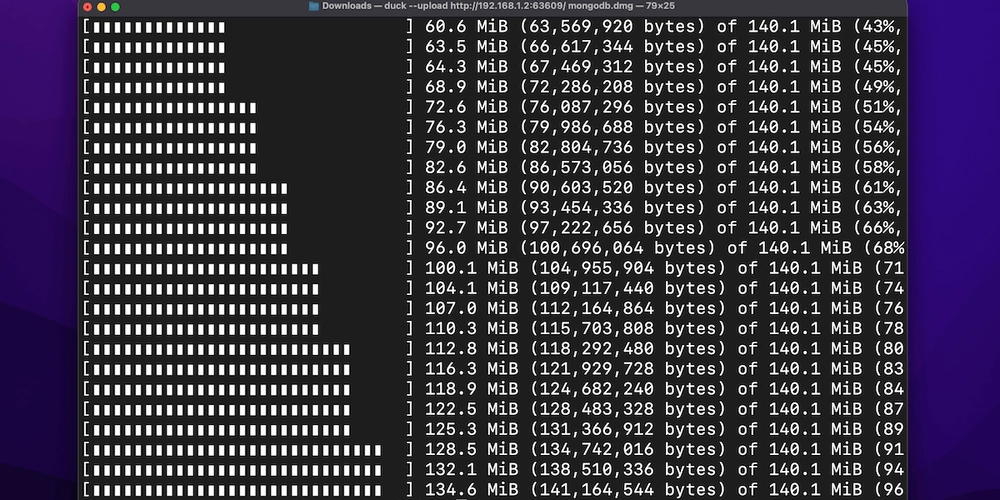
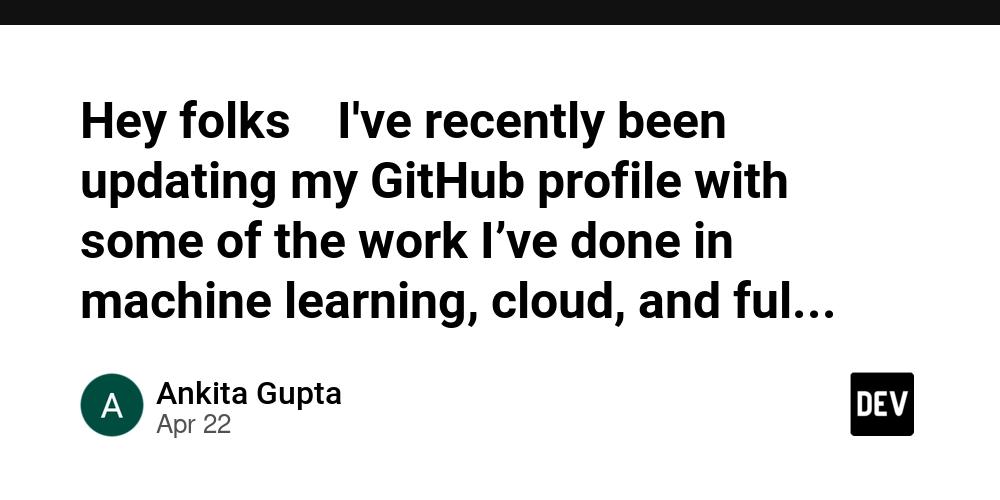
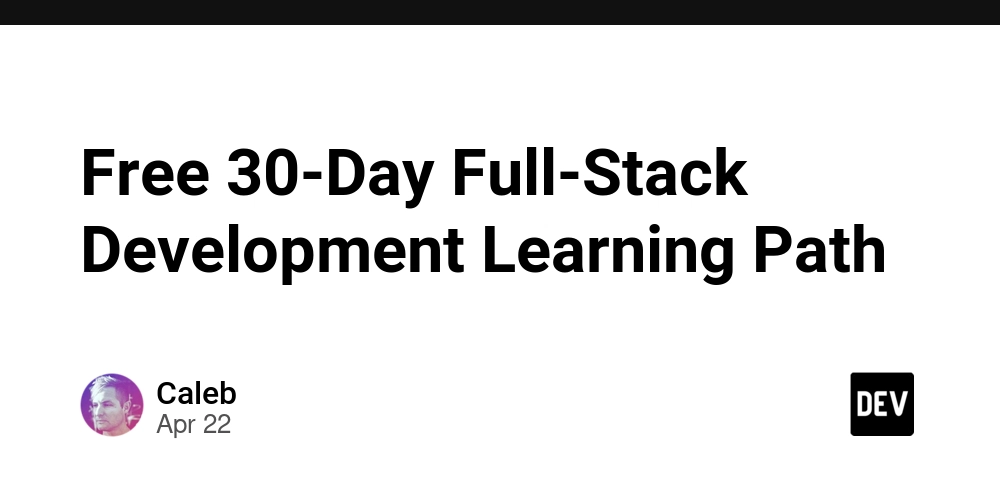














![From fast food worker to cybersecurity engineer with Tae'lur Alexis [Podcast #169]](https://cdn.hashnode.com/res/hashnode/image/upload/v1745242807605/8a6cf71c-144f-4c91-9532-62d7c92c0f65.png?#)























![BPMN-procesmodellering [closed]](https://i.sstatic.net/l7l8q49F.png)




















































































.jpg?#)
.jpg?#)

































































































































![CarPlay app with web browser for streaming video hits App Store [U]](https://i0.wp.com/9to5mac.com/wp-content/uploads/sites/6/2024/11/carplay-apple.jpeg?resize=1200%2C628&quality=82&strip=all&ssl=1)
![What’s new in Android’s April 2025 Google System Updates [U: 4/21]](https://i0.wp.com/9to5google.com/wp-content/uploads/sites/4/2025/01/google-play-services-3.jpg?resize=1200%2C628&quality=82&strip=all&ssl=1)












![Apple Releases iOS 18.5 Beta 3 and iPadOS 18.5 Beta 3 [Download]](https://www.iclarified.com/images/news/97076/97076/97076-640.jpg)
![Apple Seeds visionOS 2.5 Beta 3 to Developers [Download]](https://www.iclarified.com/images/news/97077/97077/97077-640.jpg)
![Apple Seeds tvOS 18.5 Beta 3 to Developers [Download]](https://www.iclarified.com/images/news/97078/97078/97078-640.jpg)
![Apple Seeds watchOS 11.5 Beta 3 to Developers [Download]](https://www.iclarified.com/images/news/97079/97079/97079-640.jpg)



















